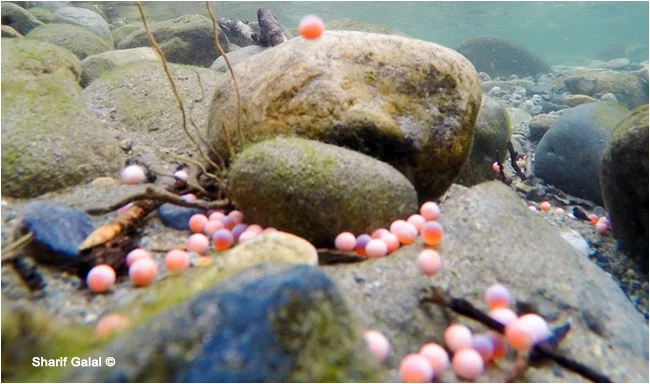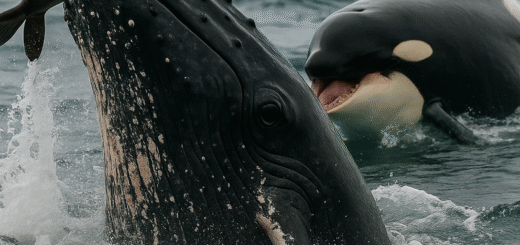Salmon Run- The Story Behind The Last Journey of Salmon

The life of a salmon is nothing short of legendary. It is a story that has fascinated biologists, environmentalists, fishermen, and even casual nature lovers for centuries. Probably one of the most awesome parts of this story is the salmon run, the last journey salmon make to migrate back to their birthplace to spawn, ensuring the survival of their species. It’s a life or death pilgrimage filled with immense challenges, determination, and sacrifice.
In this post, we delve deep into the incredible journey of the salmon run: exploring where it all begins, what the salmon endure, and how they ready themselves for one of nature’s greatest survival challenges. From battling currents and predators to leaping waterfalls, this is the extraordinary tale of their final voyage.
What is Salmon Run?
A salmon run is an extraordinary fish migration event where many Salmonid species, such as both Pacific and Atlantic salmon, migrate from the ocean back to the freshwater rivers where they were born. These fish, which live most of their adult lives in the ocean, begin their lives in freshwater. After hatching the young salmon remain in these rivers and streams for some time, slowly gathering strength before taking on a migration journey downstream to the sea. They live in the sea for several years, feeding and growing until they reach sexual maturity.

As adult salmon approach reproductive age, an incredible transformation begins. Driven by instinct, they start their journey back to the very rivers and streams where they were born. This migration is a hard one, as they have to swim against the current, usually swimming hundreds or even thousands of miles upstream. They are returning to spawn, and in most cases, this will be their final journey.
While migrating into freshwater for spawning, salmon undergo extreme physiological changes, including color change. While they are silver in the ocean, their bodies transform into vibrant colors once they enter freshwater.
Sockeye salmon turn bright red with green heads, and the male Coho develop a reddish colored body. These color changes signal maturity and help attract mates. Male salmon also develop hooked jaws (kypes) and sharper teeth to compete with other males during spawning. These transformations are part of the salmon’s preparation for reproduction on their final journey.

After spawning, all species of Pacific salmon, such as Chinook, Sockeye, Coho, Pink, and Chum, die as part of their natural life cycle. This process is known as semelparity, where an organism reproduces once and then dies. In other words, all the energy from Pacific salmon is transfers to the spawning process, leaving them physically depleted and unable to survive afterward. Their bodies deteriorate as they utilize their energy reserves to make the long, exhausting journey upstream, and to produce and lay eggs.
Similarly, most Atlantic salmon also die after spawning, but with one notable difference, unlike the Pacific salmon, a few percentages of Atlantic salmon survive the spawning process and are able to return to the ocean. These survivors are called repeat spawners, can potentially make the migration and spawning journey several times in their lifetime. However, post spawning survival is rare even in Atlantic salmon, since this journey usually takes a great deal of toll on their health and energy reserves.
Why Do Salmon Migrate?
The big question: Why do salmon go through all this trouble in the first place? Why not just reproduce in the ocean?
Well it all comes down to survival. The journey from the ocean back to freshwater might seem like an exhausting, dangerous trip, but salmon undertake it for a very specific reason. By returning to their birthplace, salmon are giving their young the best possible chance of survival.
Freshwater environments, particularly the lakes and rivers where salmon were born, offer several critical advantages for their eggs and young,

Fewer Predators
In the ocean, the eggs of salmon would be highly susceptible to predators. By returning to freshwater, especially to smaller rivers and streams, salmon can lay their eggs in areas that many of the large ocean predators cannot reach. This will greatly enhance the chances of the eggs being able to develop safely.
Ideal Conditions for Egg Development
The cold, clean waters of freshwater streams serve as a perfect environment for salmon eggs to hatch. Such streams tend to have the right amount of oxygen and cooler temperatures, which are vital for the eggs’ development. On the other hand, the ocean may hold salty and warmer waters, aren’t suitable for this delicate process.

The Perfect Spawning Grounds
Freshwater rivers with gravel beds provide an ideal environment for laying eggs. Salmon instinctively know to dig nests, called redds, in the gravel where their eggs can be safely tucked away. Gravel protects the eggs from currents that might otherwise wash them downstream, and it also provides a hidden, safe environment where the young salmon can develop before they emerge.
Returning to Familiar Waters
Salmon return to the same river where they were born because they instinctively know it as their habitat. This tried and true method, which has worked for generations, involves salmon betting on an environment that supported their development successfully. It is likely to be a safe place for their offspring too.
This migration is, after all, a high risk, high reward strategy. Salmon endure the challenges of swimming upstream to avoid the ocean’s dangers, finding and providing a head start for the next generation. Salmon populations have thrived and persisted for millions of years thanks to this brilliant evolutionary approach. Through this grueling journey, they ensure the survival of their species by passing on the legacy of endurance and adaptability to each new generation.
How Do Salmon Navigate To The Same River?
One of the most fascinating aspects of the salmon run is how these fish manage to return to the same river and often to the exact gravel bed in which they were born. Scientists have long been puzzled by the precision of this homing instinct, and though there is still much to learn, there are a few theories that help explain just how salmon achieve this significant feat.

Magnetoreception
It is believed that salmon use the Earth’s magnetic field to navigate through the open ocean. This remarkable ability, known as magnetoreception allows them to find their general location relative to their natal river. Essentially, the Earth’s magnetic field serves as a guiding map for salmon, leading them back to their place of birth.
Sense of Smell
Once salmon are near their home river, they rely on their sense of smell to find the exact location of their natal stream. In fact, salmon have an incredibly sharp olfactory sense, capable of detecting minute chemical signatures unique to their home waters. This is believed to “sniff” their way back, picking up familiar scents in the water as they make their way upstream.
Environmental Cues
In addition to magnetic fields and smell, water temperature, current direction, and even the position of the sun are all environmental cues that could help them to navigate. These factors would help them to fine tune their route back to spawning grounds.
Challenges of The Salmon Run
Strong Currents
During their migration, salmon face the daunting challenge of swimming against powerful river currents. Consequently, they must cover hundreds of miles to reach their spawning grounds. However their bodies are perfectly adapted for this task. Salmon have remarkably enduring and strong bodies, enabling them to navigate through fast moving waters with relentless determination. Salmon use their muscular, streamlined bodies to push through the rushing currents, ensuring they can reach their destination despite the exhausting journey. This physical resilience is a key reason why salmon successfully complete their challenging upstream migration
Waterfalls and Rapids

Salmon face another serious barrier along their journey, commonly encountering waterfalls and rapids. They must leap out of the water to overcome these obstacles, showcasing impressive strength and agility. For example, some species like chinook salmon can jump as high as 12 feet to clear these barriers. Witnessing salmon leap over waterfalls is a dramatic and amazing sight during the salmon run. Their ability to perform these high jumps demonstrates the extraordinary physical abilities that help them continue their migration to reach their spawning grounds.
Predators

Predators pose a significant threat to salmon during their migration. Many animals depend on salmon as a vital food source. Bears, eagles, seals, and other predators await their annual feast as salmon travel upstream. In places like Alaska, it is an iconic and widely photographed sight to see bears catching salmon mid leap. Predators strategically time their hunting to coincide with the salmon run, taking advantage of the fish’s temporary vulnerability. Despite these dangers, salmon continue their journey, driven by their instinct to reproduce.
Human Made Barriers
Salmon do not return to the ocean when they encounter a blocked path, such as a dam or another man made barrier. They continue to search for a way upstream, often exhausting themselves in the process, driven by their instinct to spawn. If they are unable to find an alternative route to their spawning grounds, they ultimately die without reproducing. Such barriers commonly lead to the significant declines in salmon populations in affected areas. Even with these interventions, Their powerful instinct to reproduce keeps them pushing forward, even if the journey becomes impossible.
Exhaustion
Once salmon enter freshwater to begin their upstream journey, they completely stop feeding. From that point on, they exclusively rely on the energy reserves they accumulated during their time in the ocean. These reserves fuel their arduous journey against strong currents, over rapids, and past obstacles. By the time they reach their spawning grounds, most salmon are completely exhausted, having spent all their stored energy. This extreme physical depletion causes the death of most salmon shortly after spawning. Their final act of reproduction ensures the continuation of their species, but it comes at the ultimate cost of their own lives.
The Ecological Importance of the Salmon Run
The salmon run is not just a vital event for the salmon themselves. In fact, it plays an important role in maintaining the health of entire ecosystems. Salmon bring nutrients from the ocean to freshwater when they return to spawn, depositing them into rivers and surrounding landscapes. These marine derived nutrients, including nitrogen and phosphorus, are critical for the ecosystems they migrate through.
The decaying bodies of the salmons bring back these nutrients into the water and soil after their spawning, enriching the environment with nutritional elements that support a wide array of organisms. Aquatic plants, insects, and microorganisms in the rivers feed on the salmon, serving as food for other species. On land, predators such as bears and birds consume large quantities of salmon during the run. The remains of the fish, uneaten, left in the riverbanks and forests further decompose, adding to the fertilizer that nourishes the soil for plant development.


This nutrient cycle is so important that the health of certain forests is directly linked to the success of salmon runs.
Conclusion: A Fish’s Last Journey
The salmon run is indeed one of the most incredible spectacles nature could ever witness. It is a story of survival, resiliency, and sacrifice. Being put through countless challenges, the fish still swim upstream against the current, beating all the odds.
So next time you enjoy a plate of salmon, take a moment to appreciate the incredible journey that fish went through. The salmon run is not just a journey for the fish, it’s part of the ecosystem, a testament to the will of nature to survive, and a reminder of our obligation to preserve this wonder of nature.




Great line up. We will be linking to this great article on our site. Keep up the good writing.